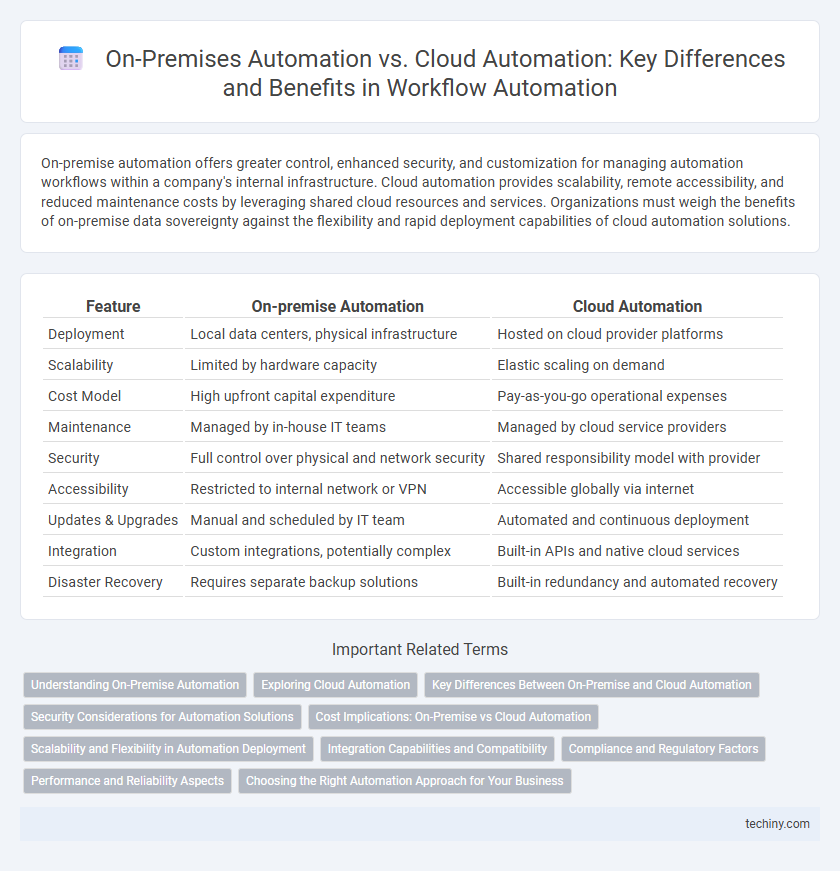On-premise automation offers greater control, enhanced security, and customization for managing automation workflows within a company's internal infrastructure. Cloud automation provides scalability, remote accessibility, and reduced maintenance costs by leveraging shared cloud resources and services. Organizations must weigh the benefits of on-premise data sovereignty against the flexibility and rapid deployment capabilities of cloud automation solutions.
Table of Comparison
| Feature | On-premise Automation | Cloud Automation |
|---|---|---|
| Deployment | Local data centers, physical infrastructure | Hosted on cloud provider platforms |
| Scalability | Limited by hardware capacity | Elastic scaling on demand |
| Cost Model | High upfront capital expenditure | Pay-as-you-go operational expenses |
| Maintenance | Managed by in-house IT teams | Managed by cloud service providers |
| Security | Full control over physical and network security | Shared responsibility model with provider |
| Accessibility | Restricted to internal network or VPN | Accessible globally via internet |
| Updates & Upgrades | Manual and scheduled by IT team | Automated and continuous deployment |
| Integration | Custom integrations, potentially complex | Built-in APIs and native cloud services |
| Disaster Recovery | Requires separate backup solutions | Built-in redundancy and automated recovery |
Understanding On-Premise Automation
On-premise automation involves deploying automation tools and software within an organization's physical infrastructure, providing greater control over data security and compliance. It enables customization tailored to specific internal processes, ideal for businesses with strict regulatory requirements or limited internet connectivity. However, it requires significant upfront investment in hardware, maintenance, and IT expertise compared to cloud automation solutions.
Exploring Cloud Automation
Cloud automation leverages scalable resources across distributed servers, enabling real-time updates and seamless integration with AI-driven workflows. It reduces infrastructure costs and enhances operational agility compared to traditional on-premise automation, which relies on localized hardware and manual maintenance. Cloud platforms like AWS, Azure, and Google Cloud offer advanced automation tools that optimize deployment, monitoring, and security in dynamic environments.
Key Differences Between On-Premise and Cloud Automation
On-premise automation requires organizations to manage their own infrastructure, offering greater control and customization but higher upfront costs and maintenance responsibilities. Cloud automation provides scalable, flexible resources with lower initial investments and faster deployment times, leveraging provider-managed security and updates. Data sovereignty and latency concerns often influence the choice between these two automation models, impacting compliance and performance depending on business needs.
Security Considerations for Automation Solutions
On-premise automation offers enhanced security control by keeping data within a localized network, reducing exposure to external threats and enabling stricter access management tailored to organizational policies. Cloud automation leverages advanced encryption, continuous monitoring, and compliance certifications but introduces potential risks related to data sovereignty and shared infrastructure vulnerabilities. Balancing these security considerations requires evaluating organizational risk tolerance, regulatory requirements, and the criticality of automated processes.
Cost Implications: On-Premise vs Cloud Automation
On-premise automation typically requires significant upfront capital investment for hardware, software licenses, and ongoing maintenance, leading to higher total cost of ownership. Cloud automation offers a scalable, pay-as-you-go pricing model, reducing initial expenses and operational costs through minimized infrastructure management. However, organizations must evaluate data transfer, compliance costs, and long-term subscription fees to accurately compare financial impacts.
Scalability and Flexibility in Automation Deployment
On-premise automation offers controlled scalability through dedicated hardware, enabling organizations to tailor resources to specific workloads while maintaining data security. Cloud automation provides unparalleled flexibility by allowing dynamic resource allocation and seamless integration with diverse platforms, facilitating rapid scaling to meet fluctuating demands. Choosing between them depends on the need for immediate scalability and integration versus controlled, consistent environments.
Integration Capabilities and Compatibility
On-premise automation offers deep integration capabilities with existing legacy systems and specialized hardware due to direct control over the infrastructure, ensuring high compatibility with proprietary software. Cloud automation provides scalable integration options through APIs and supports diverse platforms, enabling seamless connectivity across distributed environments and third-party services. Enterprises must evaluate their technology stack and integration needs to choose between the tightly controlled compatibility of on-premise solutions and the flexibility of cloud-based automation.
Compliance and Regulatory Factors
On-premise automation offers greater control over data security and compliance, allowing organizations to tailor systems to meet specific regulatory requirements such as GDPR, HIPAA, or SOX. Cloud automation provides scalability and flexibility but may introduce challenges in meeting strict compliance standards due to data residency and shared infrastructure concerns. Ensuring comprehensive audit trails and encryption protocols is critical in both environments to satisfy regulatory frameworks and avoid penalties.
Performance and Reliability Aspects
On-premise automation offers higher performance stability due to dedicated local infrastructure, reducing latency and ensuring consistent response times critical for real-time operations. Cloud automation provides scalable reliability through distributed data centers and redundancy, minimizing downtime risks and enhancing disaster recovery capabilities. Evaluating network dependencies and control requirements is essential when balancing on-premise performance reliability against cloud system resilience.
Choosing the Right Automation Approach for Your Business
On-premise automation offers greater control and security by hosting infrastructure within your organization, making it ideal for businesses with strict compliance requirements or sensitive data. Cloud automation provides scalability, flexibility, and reduced upfront costs, enabling rapid deployment and seamless integration with third-party services. Selecting the right automation approach depends on your business's priorities, including budget constraints, data sensitivity, and the need for agility in operational workflows.
On-premise Automation vs Cloud Automation Infographic

 techiny.com
techiny.com